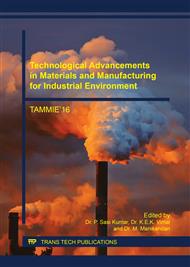p.191
p.195
p.205
p.212
p.220
p.228
p.233
p.239
p.245
Optimization of Spur Gear Design to Reduce Stress
Abstract:
The objective of the study is to reduce the stress created in the root fillet region as the maximum stress concentration in gears occurs in the fillet. Therefore, stress relieving features have been created at an offset distance from the root fillet to reduce the stress. A Spur gear with involute profile is taken for the study. The application taken for the study is the gear used in terrain vehicles. The material of the gear is EN-353 grade Steel. Based on the compressive strengths and bending strengths, the spur gear is designed to the required application. The gear is modelled using the specifications obtained from the design calculations. The forces acting on the gear is calculated considering the application in which it is used. The gear is then analysed using the ANSYS WORKBENCH 14.0 software. It has been found that the maximum stress acts near the root fillet region. Hence, stress relieving features of circular and elliptical shapes are created at an offset distance from the root fillet. It has been found that the gear with elliptical stress relieving hole has the minimum stress than those of gears with other combinations. The next objective which is to reduce the mass of the gear is done by creating larger holes in the lower stress regions of the gear. The mass reducing features are created in the gears with stress relieving features and each gear has been subjected to analysis for the minimum amount of stress. It has been found that the value of stress is less in the gear with mass reducing holes but with no stress relieving feature. Thus, the stress acting on the root fillet region has been reduced by 20% by creating circular and elliptical holes. The other objective of mass reduction is satisfied by creating larger holes.
Info:
Periodical:
Pages:
220-227
Citation:
Online since:
July 2017
Authors:
Price:
Сopyright:
© 2017 Trans Tech Publications Ltd. All Rights Reserved
Share:
Citation:


